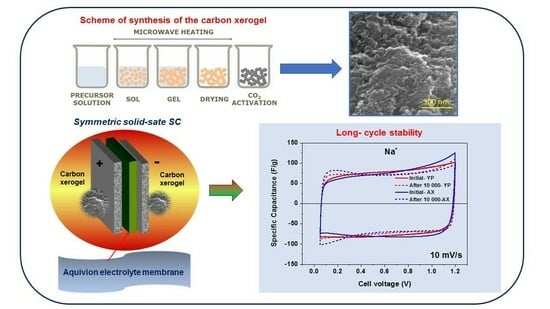Electrochemical Performance of Symmetric Solid-State Supercapacitors Based on Carbon Xerogel Electrodes and Solid Polymer Electrolytes
Abstract
:1. Introduction
2. Results and Discussion
2.1. Physical, Chemical, and Morphological Characterizations of Carbons
2.2. Electrochemical Characterization of Symmetric Supercapacitors
2.3. Long-Term Durability of the Investigated Supercapacitors
3. Conclusions
4. Experimental Section
4.1. Synthesis of Carbon Xerogels
4.2. Physicochemical Characterization of Carbon Xerogels
4.3. Preparation of the Carbon Xerogel Electrodes
4.4. Activation of the Polymer Electrolyte Membrane and Electrochemical Characterization
Author Contributions
Funding
Institutional Review Board Statement
Informed Consent Statement
Data Availability Statement
Acknowledgments
Conflicts of Interest
References
- Pérez-Madrigal, M.M.; Estrany, F.; Armelin, E.; Díaz, D.D.; Alemán, C. Towards sustainable solid-state supercapacitors: Electroactive conducting polymers combined with biohydrogels. J. Mater. Chem. A 2016, 4, 1792–1805. [Google Scholar] [CrossRef]
- Senthilkumar, S.T.; Wang, Y.; Huang, H. Advances and prospects of fiber supercapacitors. J. Mater. Chem. A 2015, 3, 20863–20879. [Google Scholar] [CrossRef]
- Li, W.; Lu, H.; Zhang, N.; Ma, M. Enhancing the Properties of Conductive Polymer Hydrogels by Freeze–Thaw Cycles for High-Performance Flexible Supercapacitors. ACS Appl. Mater. Interfaces 2017, 9, 20142–20149. [Google Scholar] [CrossRef] [PubMed]
- Zhu, L.; Uetani, K.; Nogi, M.; Koga, H. Polydopamine Doping and Pyrolysis of Cellulose Nanofiber Paper for Fabrication of Three-Dimensional Nanocarbon with Improved Yield and Capacitive Performances. Nanomaterials 2021, 11, 3249. [Google Scholar] [CrossRef] [PubMed]
- Palem, R.R.; Ramesh, S.; Yadav, H.; Kim, J.H.; Sivasamy, A.; Kim, H.S.; Kim, J.-H.; Lee, S.-H.; Kang, T.J. Nanostructured Fe2O3@nitrogen-doped multiwalled nanotube/cellulose nanocrystal composite material electrodes for high-performance supercapacitor applications. J. Mater. Res. Technol. 2020, 9, 7615–7627. [Google Scholar] [CrossRef]
- Song, N.; Tan, H.; Zhao, Y. Carbon fiber-bridged polyaniline/graphene paper electrode for a highly foldable all-solid-state supercapacitor. J. Solid State Electrochem. 2019, 23, 9–17. [Google Scholar] [CrossRef]
- Liu, H.; Zhu, G. The electrochemical capacitance of nanoporous carbons in aqueous and ionic liquids. J. Power Sources 2007, 171, 1054–1061. [Google Scholar] [CrossRef]
- Xu, B.; Wu, F.; Chen, R.; Cao, G.; Chen, S.; Wang, G.; Yang, Y. Room temperature molten salt as electrolyte for carbon nanotube-based electric double layer capacitors. J. Power Sources 2006, 158, 773–778. [Google Scholar] [CrossRef]
- Calvo, E.G.; Ania, C.O.; Zubizarreta, L.; Menéndez, J.A.; Arenillas, A. Exploring New Routes in the Synthesis of Carbon Xerogels for Their Application in Electric Double-Layer Capacitors. Energy Fuels 2010, 24, 3334–3339. [Google Scholar] [CrossRef]
- Kraiwattanawong, K.; Tamon, H.; Praserthdam, P. Influence of solvent species used in solvent exchange for preparation of mesoporous carbon xerogels from resorcinol and formaldehyde via subcritical drying. Microporous Mesoporous Mater. 2011, 138, 8–16. [Google Scholar] [CrossRef]
- Conceição, F.; Carrott, P.; Carrott, M.R. New carbon materials with high porosity in the 1–7 nm range obtained by chemical activation with phosphoric acid of resorcinol–formaldehyde aerogels. Carbon 2009, 47, 1874–1877. [Google Scholar] [CrossRef]
- Zubizarreta, L.; Arenillas, A.; Pirard, J.-P.; Pis, J.J.; Job, N. Tailoring the textural properties of activated carbon xerogels by chemical activation with KOH. Microporous Mesoporous Mater. 2008, 115, 480–490. [Google Scholar] [CrossRef]
- Maciá-Agulló, J.; Moore, B.; Cazorla-Amorós, D.; Linares-Solano, A. Influence of carbon fibres crystallinities on their chemical activation by KOH and NaOH. Microporous Mesoporous Mater. 2007, 101, 397–405. [Google Scholar] [CrossRef]
- Liu, P.; Verbrugge, M.; Soukiazian, S. Influence of temperature and electrolyte on the performance of activated-carbon supercapacitors. J. Power Sources 2006, 156, 712–718. [Google Scholar] [CrossRef]
- Maitra, S.; Mitra, R.; Nath, T. Investigation of electrochemical performance of MgNiO2 prepared by sol-gel synthesis route for aqueous-based supercapacitor application. Curr. Appl. Phys. 2020, 20, 628–637. [Google Scholar] [CrossRef]
- Wang, Z.; Tan, Y.; Yang, Y.; Zhao, X.; Liu, Y.; Niu, L.; Tichnell, B.; Kong, L.; Kang, L.; Liu, Z.; et al. Pomelo peels-derived porous activated carbon microsheets dual-doped with nitrogen and phosphorus for high performance electrochemical capacitors. J. Power Sources 2018, 378, 499–510. [Google Scholar] [CrossRef]
- Fic, K.; Lota, G.; Meller, M.; Frackowiak, E. Novel insight into neutral medium as electrolyte for high-voltage supercapacitors. Energy Environ. Sci. 2012, 5, 5842–5850. [Google Scholar] [CrossRef]
- Hughes, M.A.; Allen, J.A.; Donne, S.W. Optimized Electrolytic Carbon and Electrolyte Systems for Electrochemical Capacitors. ChemElectroChem 2020, 7, 266–282. [Google Scholar] [CrossRef]
- Karade, S.S.; Raut, S.S.; Gajare, H.B.; Nikam, P.R.; Sharma, R.; Sankapal, B.R. Widening potential window of flexible solid-state supercapacitor through asymmetric configured iron oxide and poly(3,4-ethylenedioxythiophene) polystyrene sulfonate coated multi-walled carbon nanotubes assembly. J. Energy Storage 2020, 31, 101622. [Google Scholar] [CrossRef]
- Kusoglu, A.; Weber, A.Z. New Insights into Perfluorinated Sulfonic-Acid Ionomers. Chem. Rev. 2017, 117, 987–1104. [Google Scholar] [CrossRef]
- Glukhova, O. Flexible Membranes for Batteries and Supercapacitor Applications. Membranes 2022, 12, 583. [Google Scholar] [CrossRef]
- Li, J.; Pan, M.; Tang, H. Understanding short-side-chain perfluorinated sulfonic acid and its application for high temperature polymer electrolyte membrane fuel cells. RSC Adv. 2014, 4, 3944–3965. [Google Scholar] [CrossRef]
- Stassi, A.; Gatto, I.; Passalacqua, E.; Antonucci, V.; Arico, A.; Merlo, L.; Oldani, C.; Pagano, E. Performance comparison of long and short-side chain perfluorosulfonic membranes for high temperature polymer electrolyte membrane fuel cell operation. J. Power Sources 2011, 196, 8925–8930. [Google Scholar] [CrossRef]
- Aricò, A.; Di Blasi, A.; Brunaccini, G.; Sergi, F.; Dispenza, G.; Andaloro, L.; Ferraro, M.; Antonucci, V.; Asher, P.; Buche, S. High temperature operation of a solid polymer electrolyte fuel cell stack based on a new ionomer membrane. Fuel Cells 2010, 10, 1013–1023. [Google Scholar] [CrossRef]
- Thomas, M.; Cannilla, C.; Brigandì, A.; Nicotera, I.; Lufrano, F. Nanoarchitectonics of high-performance supercapacitors based on mesoporous carbon and MnO2 electrodes using Aquivion electrolyte membrane. J. Alloys Compd. 2023, 960, 170719. [Google Scholar] [CrossRef]
- Paleo, A.; Staiti, P.; Rocha, A.; Squadrito, G.; Lufrano, F. Lifetime assessment of solid-state hybrid supercapacitors based on cotton fabric electrodes. J. Power Sources 2019, 434, 226735. [Google Scholar] [CrossRef]
- Soserov, L.; Mladenova, B.; Karamanova, B.; Lefterova, E.; Arenillas, A.; Stoyanova, A. Comparative study of electrochemical performance of symmetric supercapacitors between aqueous electrolyte and polymer exchange membrane. Monatsh. Chem. 2023. in print. [Google Scholar]
- Platek-Mielczarek, A.; Piwek, J.; Frackowiak, E.; Fic, K. Ambiguous Role of Cations in the Long-Term Performance of Electrochemical Capacitors with Aqueous Electrolytes. ACS Appl. Mater. Interfaces 2023, 15, 23860–23874. [Google Scholar] [CrossRef]
- Rey-Raap, N.; Menéndez, J.A.; Arenillas, A. RF xerogels with tailored porosity over the entire nanoscale. Microporous Mesoporous Mater. 2014, 195, 266–275. [Google Scholar] [CrossRef]
- Sahoo, M.K.; Rao, G.R. A high energy flexible symmetric supercapacitor fabricated using N-doped activated carbon derived from palm flowers. Nanoscale Adv. 2021, 3, 5417–5429. [Google Scholar] [CrossRef]
- Wang, H.; Liu, J.; Zhang, K.; Peng, H.; Li, G. Meso/microporous nitrogen-containing carbon nanofibers with enhanced electrochemical capacitance performances. Synth. Met. 2015, 203, 149–155. [Google Scholar] [CrossRef]
- Karamanova, B.; Stoyanova, A.; Shipochka, M.; Veleva, S.; Stoyanova, R. Effect of Alkaline-Basic Electrolytes on the Capacitance Performance of Biomass-Derived Carbonaceous Materials. Materials 2020, 13, 2941. [Google Scholar] [CrossRef] [PubMed]
- Yan, R.; Antonietti, M.; Oschatz, M. Toward the Experimental Understanding of the Energy Storage Mechanism and Ion Dynamics in Ionic Liquid Based Supercapacitors. Adv. Energy Mater. 2018, 8, 1800026. [Google Scholar] [CrossRef]
- Zhao, S.; Song, Z.; Qing, L.; Zhou, J.; Qiao, C. Surface Wettability Effect on Energy Density and Power Density of Supercapacitors. J. Phys. Chem. C 2022, 126, 9248–9256. [Google Scholar] [CrossRef]
- Primachenko, O.N.; Kulvelis, Y.V.; Odinokov, A.S.; Glebova, N.V.; Krasnova, A.O.; Antokolskiy, L.A.; Nechitailov, A.A.; Shvidchenko, A.V.; Gofman, I.V.; Marinenko, E.A.; et al. New Generation of Compositional Aquivion®-Type Membranes with Nanodiamonds for Hydrogen Fuel Cells: Design and Performance. Membranes 2022, 12, 827. [Google Scholar] [CrossRef] [PubMed]
- Safronova, E.Y.; Osipov, A.K.; Yaroslavtsev, A.B. Short Side Chain Aquivion Perfluorinated Sulfonated Proton-Conductive Membranes: Transport and Mechanical Properties. Pet. Chem. 2018, 58, 130–136. [Google Scholar] [CrossRef]
- Mathis, T.S.; Kurra, N.; Wang, X.; Pinto, D.; Simon, P.; Gogotsi, Y. Energy Storage Data Reporting in Perspective—Guidelines for Interpreting the Performance of Electrochemical Energy Storage Systems. Adv. Energy Mater. 2019, 9, 1902007. [Google Scholar] [CrossRef]
- Wu, T.-H.; Hsu, C.-T.; Hu, C.-C.; Hardwick, L.J. Important parameters affecting the cell voltage of aqueous electrical double-layer capacitors. J. Power Sources 2013, 242, 289–298. [Google Scholar] [CrossRef]
- Huang, M.; Yoo, S.J.; Lee, J.-S.; Yoon, T.-H. Electrochemical properties of an activated carbon xerogel monolith from resorcinol–formaldehyde for supercapacitor electrode applications. RSC Adv. 2021, 11, 33192–33201. [Google Scholar] [CrossRef]
- Okhay, O.; Tkach, A.; Staiti, P.; Lufrano, F. Long term durability of solid-state supercapacitor based on reduced graphene oxide aerogel and carbon nanotubes composite electrodes. Electrochim. Acta 2020, 353, 136540. [Google Scholar] [CrossRef]
- Boota, M.; Hatzell, K.; Alhabeb, M.; Kumbur, E.; Gogotsi, Y. Graphene-containing flowable electrodes for capacitive energy storage. Carbon 2015, 92, 142–149. [Google Scholar] [CrossRef]
- Wu, Z.-S.; Ren, W.; Wang, D.-W.; Li, F.; Liu, B.; Cheng, H.-M. High-Energy MnO2 Nanowire/Graphene and Graphene Asymmetric Electrochemical Capacitors. ACS Nano 2010, 4, 5835–5842. [Google Scholar] [CrossRef] [PubMed]
- Kim, H.; Guccini, V.; Lu, H.; Salazar-Alvarez, G.; Lindbergh, G.; Cornell, A. Lithium Ion Battery Separators Based on Carboxylated Cellulose Nanofibers from Wood. ACS Appl. Energy Mater. 2019, 2, 1241–1250. [Google Scholar] [CrossRef]
- Canal-Rodríguez, M.; Ramírez-Montoya, L.A.; Villanueva, S.F.; Flores-López, S.L.; Menéndez, J.A.; Arenillas, A.; Montes-Morán, M.A. Multiphase graphitisation of carbon xerogels and its dependence on their pore size. Carbon 2019, 152, 704–714. [Google Scholar] [CrossRef]
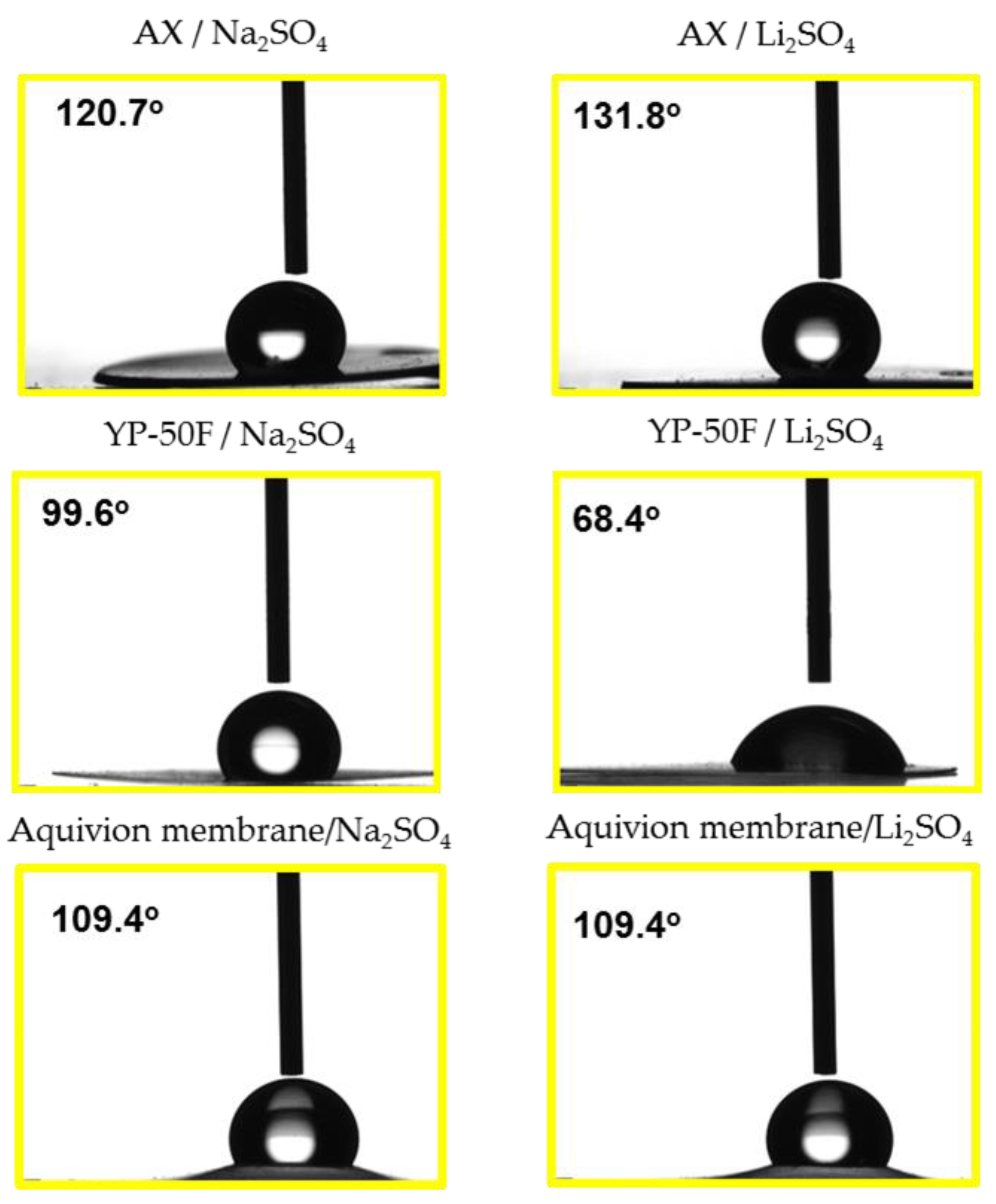
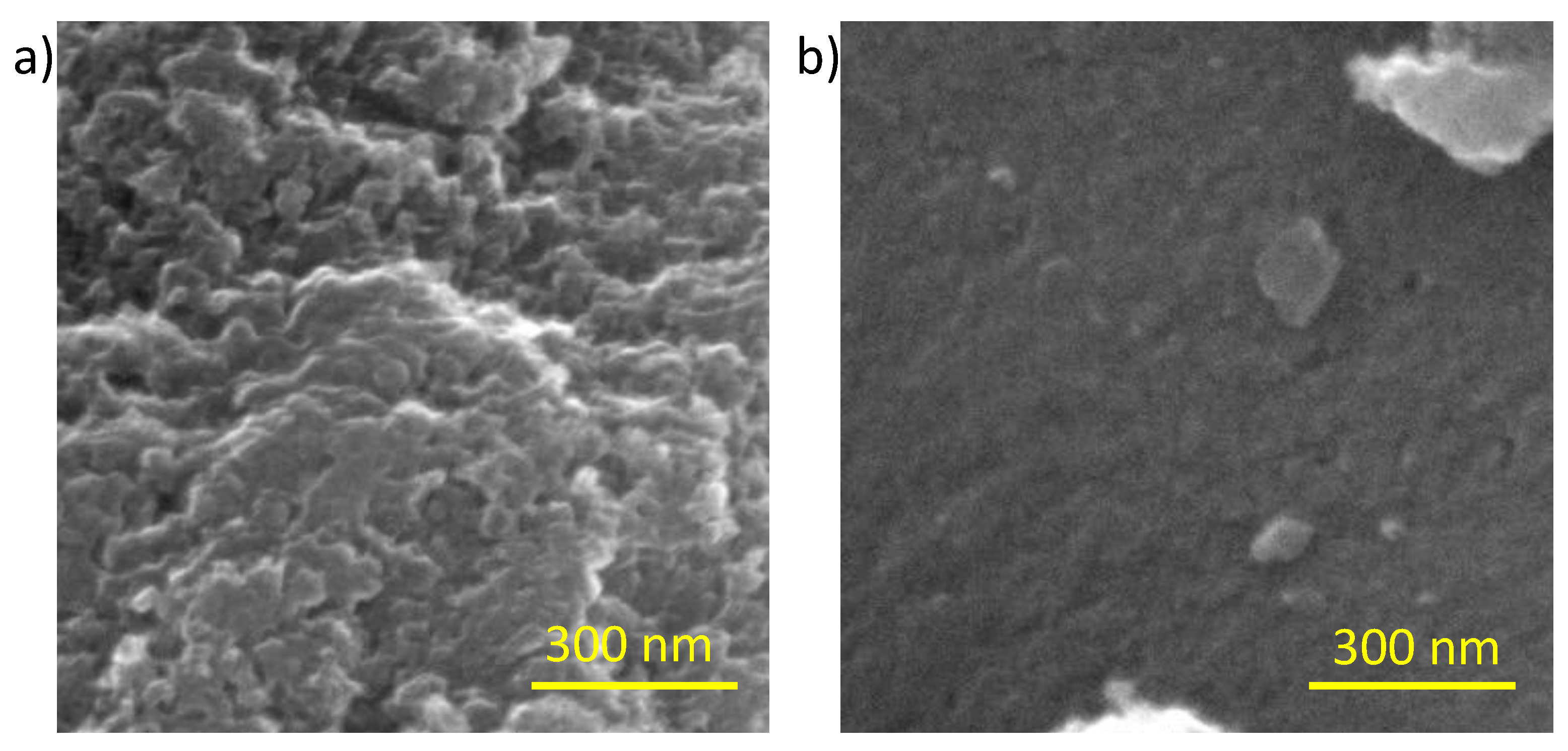
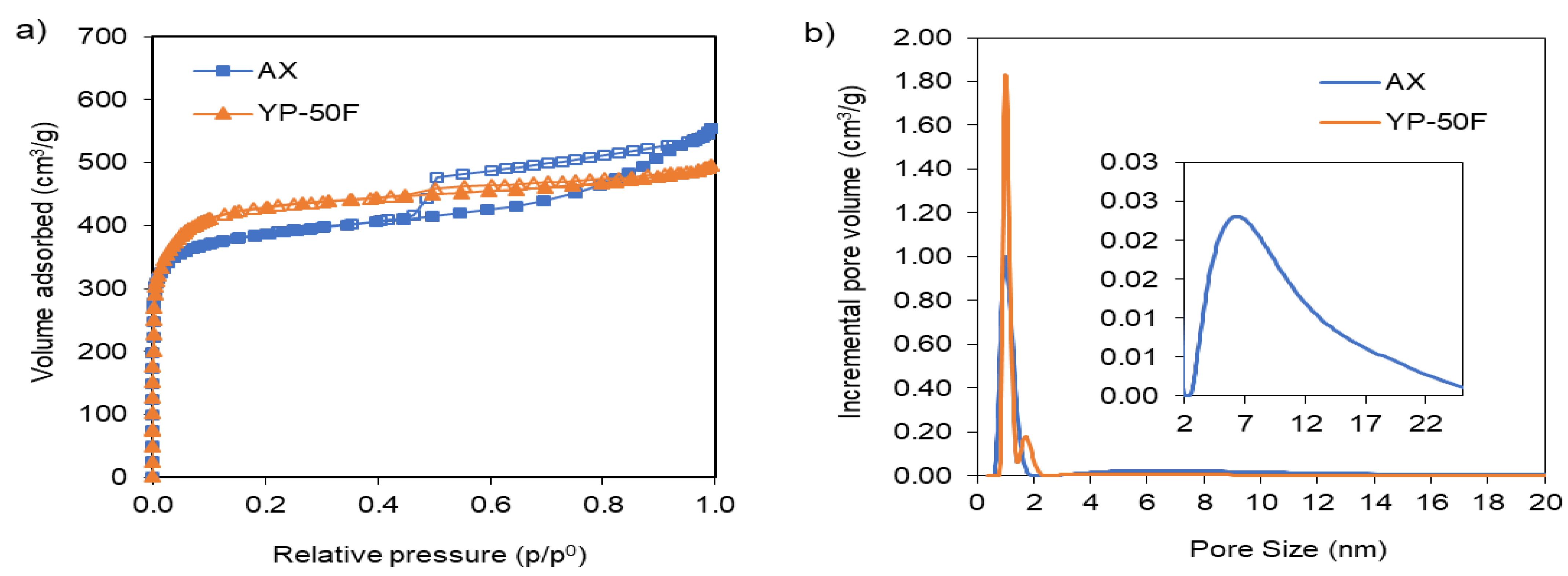


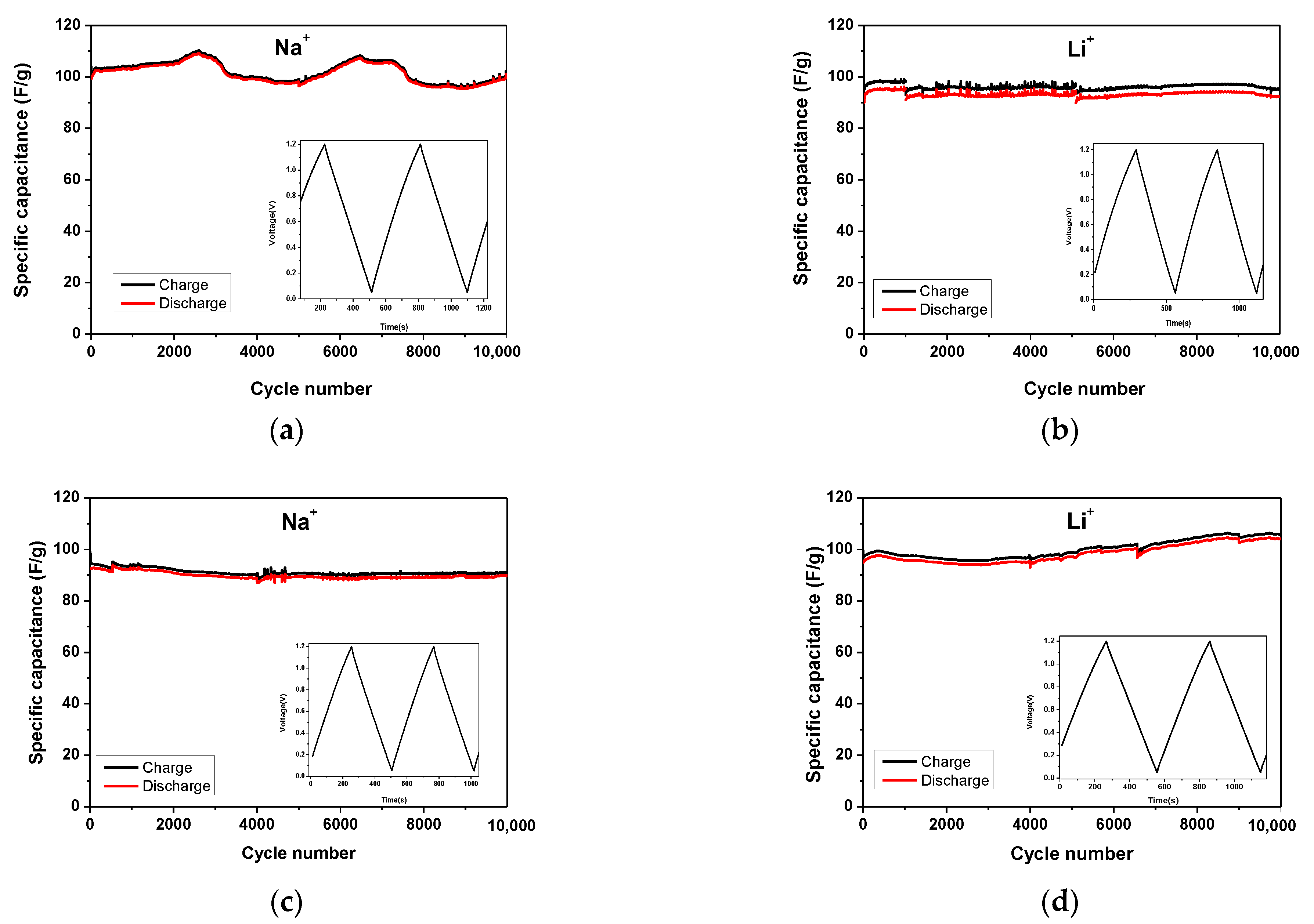
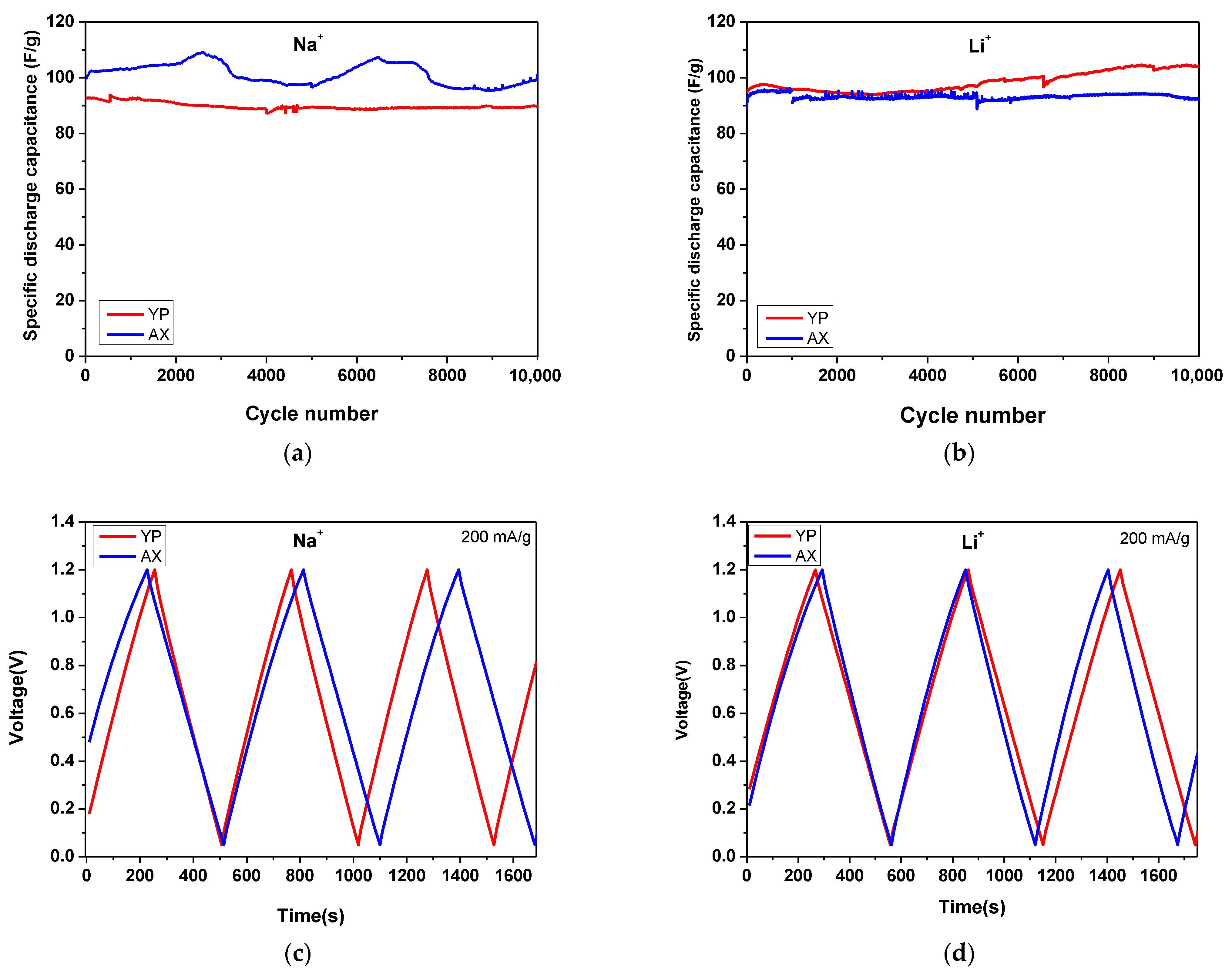



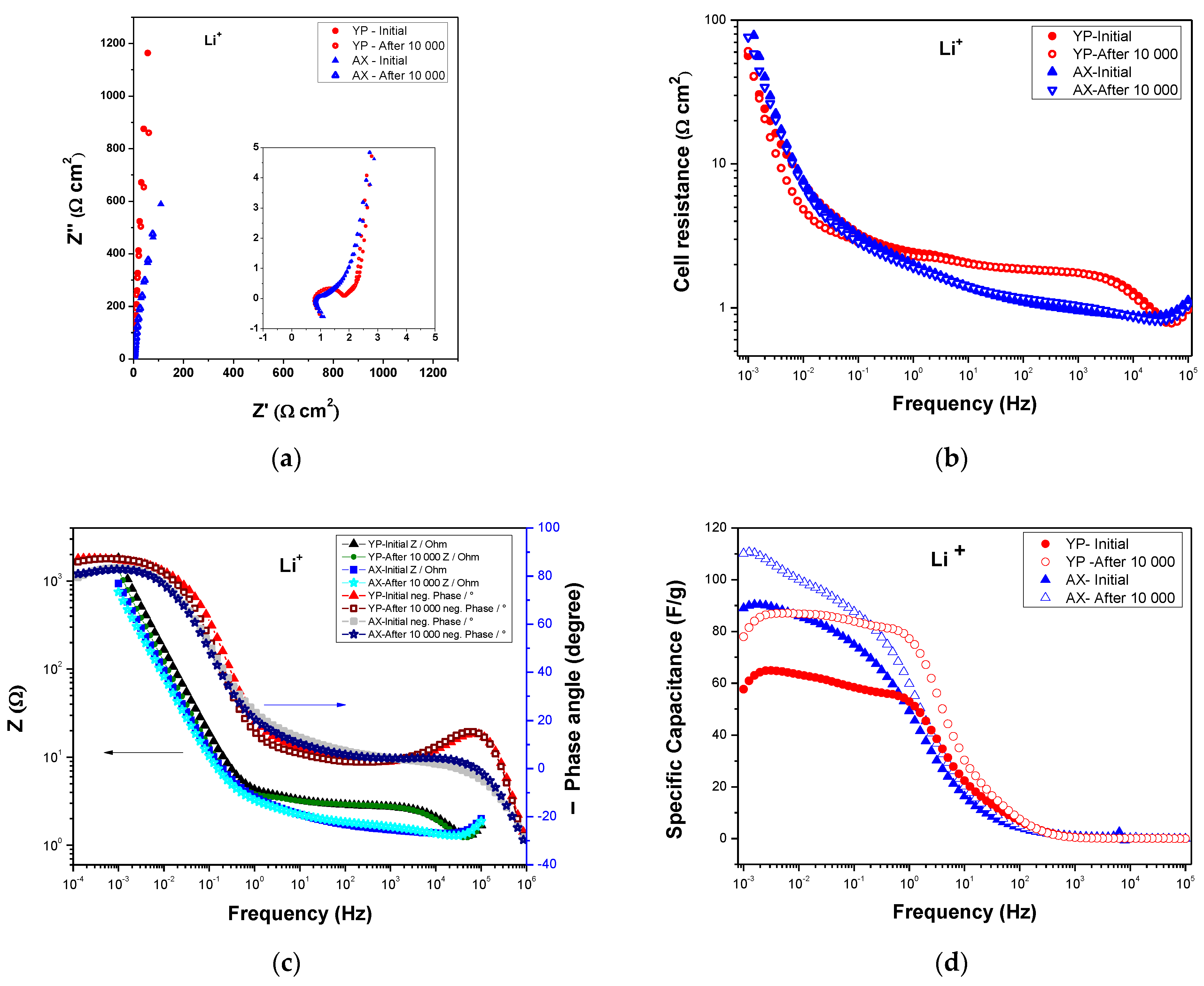

| Sample | C (wt%) | H (wt%) | O (wt%) | N (wt%) | S (wt%) |
|---|---|---|---|---|---|
| AX | 96.3 | 0.7 | 3.0 | - | - |
| YP-50F | 97.6 | 0.3 | 2.1 | - | - |
| Sample | SBET, m2 g−1 | Sext, m2 g−1 | Vmicro, cm3 g−1 | Vt, cm3 g−1 |
|---|---|---|---|---|
| AX | 1492 | 234 | 0.59 | 0.85 |
| YP-50F | 1756 | 157 | 0.62 | 0.80 |
| Coulombic Efficiency, % | 1st Cycle | After 1000 Cycles | After 5000 Cycles | After 10,000 Cycles | ||||
|---|---|---|---|---|---|---|---|---|
| Na+ | Li+ | Na+ | Li+ | Na+ | Li+ | Na+ | Li+ | |
| AX | 96 | 82 | 99 | 97 | 99 | 97 | 99 | 97 |
| YP-50F | 94 | 95 | 99 | 98 | 99 | 98 | 99 | 98 |
Disclaimer/Publisher’s Note: The statements, opinions and data contained in all publications are solely those of the individual author(s) and contributor(s) and not of MDPI and/or the editor(s). MDPI and/or the editor(s) disclaim responsibility for any injury to people or property resulting from any ideas, methods, instructions or products referred to in the content. |
© 2023 by the authors. Licensee MDPI, Basel, Switzerland. This article is an open access article distributed under the terms and conditions of the Creative Commons Attribution (CC BY) license (https://creativecommons.org/licenses/by/4.0/).
Share and Cite
Karamanova, B.; Mladenova, E.; Thomas, M.; Rey-Raap, N.; Arenillas, A.; Lufrano, F.; Stoyanova, A. Electrochemical Performance of Symmetric Solid-State Supercapacitors Based on Carbon Xerogel Electrodes and Solid Polymer Electrolytes. Gels 2023, 9, 983. https://doi.org/10.3390/gels9120983
Karamanova B, Mladenova E, Thomas M, Rey-Raap N, Arenillas A, Lufrano F, Stoyanova A. Electrochemical Performance of Symmetric Solid-State Supercapacitors Based on Carbon Xerogel Electrodes and Solid Polymer Electrolytes. Gels. 2023; 9(12):983. https://doi.org/10.3390/gels9120983
Chicago/Turabian StyleKaramanova, Boryana, Emiliya Mladenova, Minju Thomas, Natalia Rey-Raap, Ana Arenillas, Francesco Lufrano, and Antonia Stoyanova. 2023. "Electrochemical Performance of Symmetric Solid-State Supercapacitors Based on Carbon Xerogel Electrodes and Solid Polymer Electrolytes" Gels 9, no. 12: 983. https://doi.org/10.3390/gels9120983





